Jewellery - Recent acquisitions - Sold antiquities
Archive of sold antiquities
All artefacts sold in our gallery are fully documented in our online archive and database. Being a specialist ancient art dealer, preserving also the more recent history of each and every piece sold in our shop is at our heart. That is particularly useful for artefacts that changed owners in the meantime. Information that may have been lost in the process can be easily restored from our archives. Please do not hesitate to contact us if you need further information about ancient items that have been sold in our gallery. We can help you with reconstructing the history of ownership for those items. All information about our customers will be kept confidential, of course.-
 Roman intaglio with child Eros and bow
Roman intaglio with child Eros and bowThe glass paste shows the god as a boy, standing with his bow in one hand. From the Professor Brosch collection of engraved gems.
Price: on request Roman intaglio with young Eros
Roman intaglio with young ErosIt shows the god with his upper body leaning forward, the left leg raised and bent. Magnificent orange glass paste with iridescent patina.
Price: on request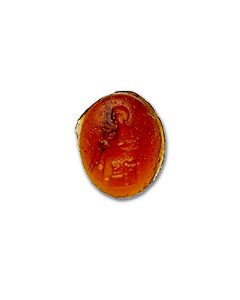 Roman intaglio with person on a chair
Roman intaglio with person on a chairMade of bright orange glass paste. From the Professor Brosch collection of engraved gems.
Price: on request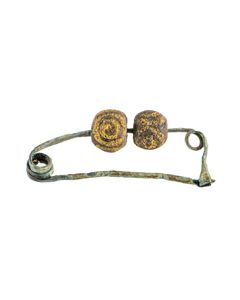 Early Italic brooch decorated with beads
Early Italic brooch decorated with beadsThere rare brooch type from northern Italy is based on predecessors from Greece. The piece is from the famous Richard Hattatt collection and is published in two of his works.
Price: on request Large Villanovan fibula from the Hattatt collection
Large Villanovan fibula from the Hattatt collectionImposing bronze brooch of the Italic Iron Age. The piece is published in the standard work "Brooches of Antiquity".
Price: on request Luristan ibex pendant
Luristan ibex pendantMassive bronze pendant in the shape of a standing ibex with long horns. From Iron Age Luristan.
Price: on request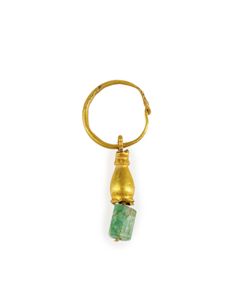 Roman gold earring with emerald
Roman gold earring with emeraldBeautiful jewellery from the 2nd century made of gold with a green stone bead.
Price: on request Griechisch-römische Goldohrringe
Griechisch-römische GoldohrringeDie griechisch-römischen Ohrringe besitzen kunstvolle Granularien. Das Paar ist mehrfach publiziert.
Price: on request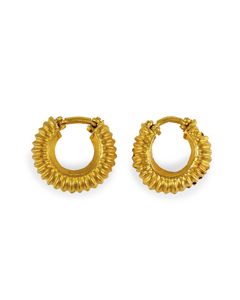 Griechisches Goldohrringpaar
Griechisches GoldohrringpaarWunderschöne antike Ohrringe aus Gold. Griechische Zeit.
Price: on request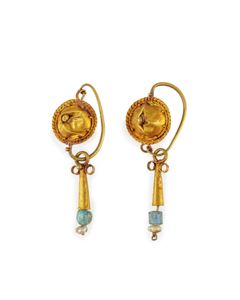
 Italic fibula with nice incised decoration
Italic fibula with nice incised decorationLarge bronze brooch of a typical boat-shape from Iron Age Italy. A special feature and rarity are the three links of a chain still hanging on the pin.
Price: on request Villanovan fibula from the Hattatt collection
Villanovan fibula from the Hattatt collectionSerpentine bronze brooch of the Italic Iron Age. The piece is published in the standard work "Brooches of Antiquity".
Price: on request Villanovan fibula from the Hattatt collection
Villanovan fibula from the Hattatt collectionBronze brooch of the Italic Iron Age. The piece is published in the standard work "Brooches of Antiquity".
Price: on request Luristan horse pendant
Luristan horse pendantThe spectacular creature with conjoined horse bodies is characteristic for the bronze works of Lurstian. From the early 1st Millenium BC.
Price: on request Luristan ibex pendant
Luristan ibex pendantMassive bronze pendant in the shape of a standing ibex with curved horns. From Iron Age Luristan.
Price: on request Roman intaglio inscribed DIOGENOY
Roman intaglio inscribed DIOGENOYThe gemstone made of red carnelian bears the inscription DIOGENOY. From the Roman period with original remains of the iron ring.
Price: on request Roman glass fragments from the Rhineland
Roman glass fragments from the RhinelandFragments of glass vessels and rods, as well as two faience beads. Finds from the Roman city of Novaesium, today's Neuss in Germany.
Price: on request Eight Roman bronze artifacts
Eight Roman bronze artifactsVarious artifacts in different states of preservation. Finds from the Roman city of Novaesium, today's Neuss in Germany.
Price: on request Eight Roman bronze artefacts
Eight Roman bronze artefactsVarious artefacts in different states of preservation. Finds from the Roman city of Novaesium, today's Neuss in Germany.
Price: on request Egyptian mummy beads necklace
Egyptian mummy beads necklaceModern assembled and threaded necklace made from original ancient Egyptian beads. The socalled mummy beads are made of faience and date to the Late Period of ancient Egypt.
Price: on request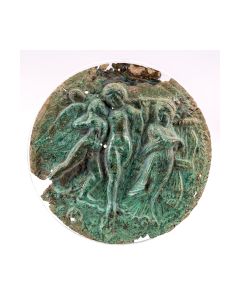 Published Etruscan mirror with Dionysian scene
Published Etruscan mirror with Dionysian sceneSubject of extended scientific analysis, one of only about 34 known specimen. High quality work, excellent condition. Described by Prof. Jucker as "small piece of art". From an old Swiss private collection. Overall in exceptional condition with thoroughly worked details.
Price: on request Jama-Coaque roller stamp
Jama-Coaque roller stampClay roller stamp with relief of plants to be applied as skin decoration. This tool was used in the early phase of the ecuadorian Jama-Coaque culture.
Price: on request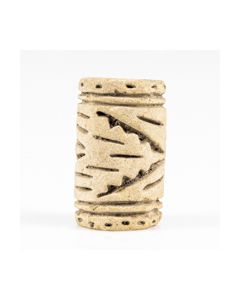 Jama-Coaque roller stamp
Jama-Coaque roller stampClay roller stamp with relief of stylized plants used to apply skin decoration. This tool is from the early phase of the ecuadorian Jama-Coaque culture.
Price: on request Pannonian trumpet brooch
Pannonian trumpet broochWell preserved Roman silver fibula with curved bow. The type is from the Pannonian provinces of Rome and dates to the 2nd century.
Price: on request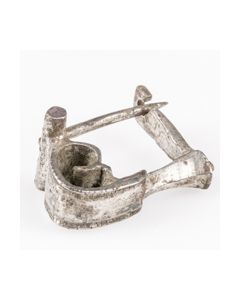 Roman silver fibula from Pannonia
Roman silver fibula from PannoniaInteresting brooch type from the Roman Pannonian provinces. A very similar piece was found near the Roman camp and settlement of Carnuntum in what is now Austria.
Price: on request Egyptian hippopotamus amulet
Egyptian hippopotamus amuletMade in the style of a scarab but with a hippopotamus on the upper side. It was a protective amulet during the 18th or 19th dynasty of Ancient Egypt. It might have protected a pregnant woman. The amulet comes from the famous Matouk collection and is published in his 1971 book.
Price: on request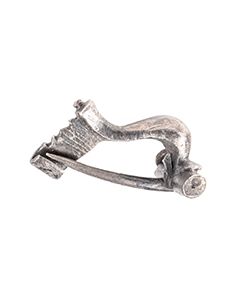 Roman silver knee brooch
Roman silver knee broochNice specimen with characteristic bend in its bow and attached loop and ring. From the Danubian provinces of the Roman Empire.
Price: on request Syrian amulet in animal shape
Syrian amulet in animal shapeSmall amulet of nice red stone in the stylized shape of a pig. From the 3rd Millenium BC.
Price: on request Etruscan "a baule" type earrings
Etruscan "a baule" type earringsSkilfully made pair of gold earrings with filigree. The ancient jewellery is from the Golden Age of the Etruscans around the 6th century BC.
Price: on request Pair of early Byzantine gold earrings
Pair of early Byzantine gold earringsBeautiful jewellery with beads made of emerald and garnet. Made in the eastern part of the Mediterranean during the 6th to early 7th century.
Price: on request Roman silver knee brooch
Roman silver knee broochNice specimen with characteristic bend in its bow and incised decorations. From the Danubian provinces of the Roman Empire.
Price: on request Sumerian miniature ram amulet
Sumerian miniature ram amuletNice small stone amulet in the stylized shape of a ram. From the 3rd Millenium BC.
Price: on request Egyptian headrest amulet
Egyptian headrest amuletInteresting weres amulet type based on larger headrests that served the Egyptians as pillows. From the Boston Museum of Fine Arts collection. Late Period of Ancient Egypt.
Price: on request Sumerian ram amulet
Sumerian ram amuletNice small stone amulet in the stylized shape of a ram. From the 3rd Millenium BC.
Price: on request Etruscan "a baule" type earrings
Etruscan "a baule" type earringsSkilfully made pair of gold earrings with filigree. The ancient jewellery is from the Golden Age of the Etruscans around the 6th century BC.
Price: on request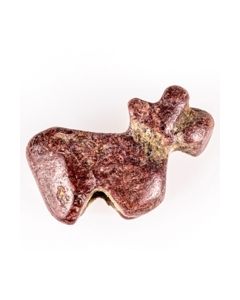 Sumerian miniature ram amulet
Sumerian miniature ram amuletNice small stone amulet in the stylized shape of a ram. From the 3rd Millenium BC.
Price: on request

